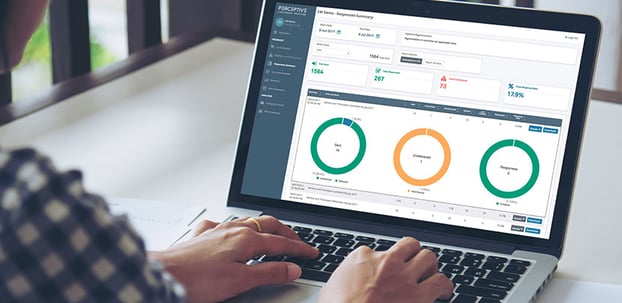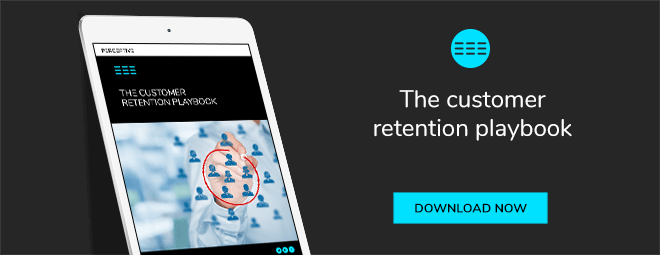You may have heard of the Net Promoter Score (NPS) mentioned in relation to measuring customer retention and customer loyalty levels. It’s a metric often used in alongside referral rates and word-of-mouth.
Understanding the NPS score
NPS is a survey emailed to your customers asking them how likely they are to recommend your business to someone else. Customers rank their answer on a scale of 0 (highly unlikely) to 10 (highly likely). Based on their answers, customers are categorised into one of three groups:
- Promoters (9 to 10).
- Passives (7 to 8).
- Detractors (0 to 6).
In addition to this, most businesses choose include a few follow up questions to help them understand why customers gave them the rating they did.
The formula to get your overall NPS score is the percentage of your customers who are detractors, subtracted from the percentage that are promoters. This provides an overall score between -100 and 100.
NPS is not just a simple number. It's a comprehensive system that can massively impact your retention levels and business growth. However, to do this, it needs to be implemented in the right way.
Learn more: How to calculate NPS

Why use NPS?
Research from Bain & Co has found that companies with the top NPS in their market grow two times faster than their competitors. It's a powerful methodology that businesses critical insights into what customers think of their brand. Often, NPS is a reality check for companies, as it exposes how their business is performing. It’s also an indicator of future growth as you are in effect measuring your customer satisfaction levels (the potential for repeat business and word-of-mouth through referrals).
NPS enables your business to:
- Measure how healthy your customer relationship is over a period of time, and do so continually
- Receive actionable customer data, identifying and targeting important customer segments and even competitors
- Close the loop between employees and customers to make sure you improve your services on a continuous basis
- Understand what exact initiatives create your promoters and detractors
- Track your customer experience to identify the key touch-points where you can improve your service, resolve issues and provide additional support.
Measure your customer loyalty concretely
To actually put a concrete number on how loyal your customer base is, many companies today across the globe use the Net Promoter Score as an established method for measuring loyalty over time because it’s not only easy to use but also has a direct connection to profitability.
You're essentially measuring your customer satisfaction and the likelihood of your current customers to recommend your business, thereby you're able to measure your customer loyalty and retention rates. Not convinced? The following is a statistic that we love to use to describe this.
It has been demonstrated that companies with the top NPS scores in their industry outgrow their companies by 20%.1
Getting strategic, actionable insights will mean that your customer feedback survey will pay for itself in the long run, and you’ll able to make solid business decisions based on the insights provided. Check out our case study on how Wesfarmers made customer experience work for them.
Related content: Measure your competitive edge with NPS benchmarking
Customer retention trumps acquisition any day
When you know how many of your customers are unhappy, and what you need to know to keep them loyal, you are on your way to increasing your customer acquisition rates. Basically, keeping your existing customers loyal is more cost efficient than constantly trying to acquire new customers.
The stats say it all: a 5 per cent lift in customer retention will actually result in an increase in profit in upwards of 25 per cent.2
Having invested into your CEM solution will pay for itself when considering the lifetime value of saved customers.
Save customers before they leave
When the NPS methodology is combined with the right software, you can also identify and personally contact your "most at risk" customers, i.e. those who are most likely to stop using your products or services. By resolving their issue(s) quickly there's a strong possibility you can stop them from churning. In addition, you'll get a valuable insight into why they want to leave. With that knowledge, you can uncover you need to improve on to retain your existing customers as well as acquire new ones.
Manage each customer segment differently
NPS will segment your customers into three categories: detractors, passives and promoters. Each segment requires a different approach to manage.
1. Detractors
Detractors are the customers who gave you low scores (between 0 and 6). These people are not happy with your product or service. Moreover, their perception can damage to your brand in the market, particularly through negative word of mouth. However, it’s not all bad news.
There is a lot you can learn from this group. They present an ideal opportunity to understand what has gone wrong in their experience. Don’t be afraid to hear what they have to say. Instead, welcome their feedback and use it to improve your business.
Tip! Ask your detractors what the one thing you could do to change their score to a 9 or 10 next time. Now you know what you need to do to change your business around.
2. Passives
When passives score you a 7 or an 8, they're on the fence. They can become promoters, but just as easily, they can become detractors, so it's critical you take care of them.
The key to managing this group is to really get to know them. Understand their situation, their issues, what’s important to them and what gets under their skin. This is where the insights from NPS really proves its worth.
To win passives over, go above and beyond what's required. Show them you can add that value to them and use your insights to personalise their experience as best you can. Consider offering free upgrades or collateral. If you’re a B2B, why not provide recent market information or trend predictions for the upcoming year? This is the kind of thing that can turn passives around.
Tip! Remember, whatever you give away must be of real value and relevant to your customers.
3. Promoters
Promoters are your most satisfied customers. Moreover, they’re willing to recommend you to others. Many actively do so, however, some are more reserved. We call them “passive” promoters.
Passive promoters present a great opportunity to grow your word-of-mouth and brand awareness. Ask them for a testimonial or prompt them to share your business on social media. If you can do this automatically with your customer loyalty software, even better.
Summary
One of the major strengths of NPS is its ability to generate the insights you need to grow relationships with your customers, and thereby retain them longer. It also allows you to identify the customer pain points that are damaging their brand experience and actively resolve them.
Moreover, NPS helps to identify your most loyal customers and brand advocates—and create more of them. When you know exactly what turns customers into raving fans, you know what to do to get more of them talking about you, more often.
If you want to learn more about customer retention strategies, check out our free eBook below:
1. Bain & Co. 'How the Net Promoter Score Relates to Growth'. www.netpromotersystem.com.
2. Gallo, A. 'The Value of Keeping the Right Customers', Harvard Business Review.
